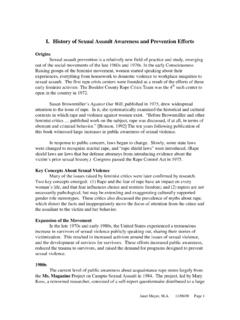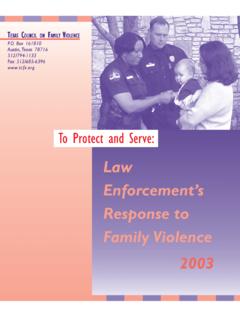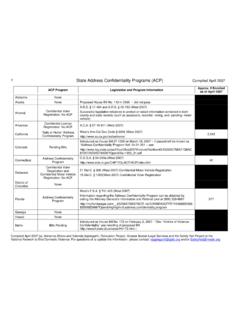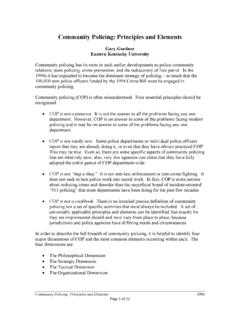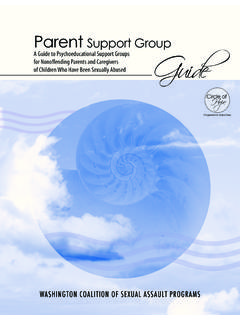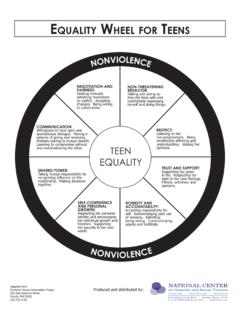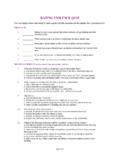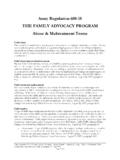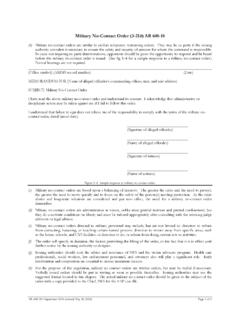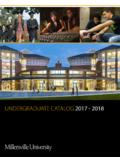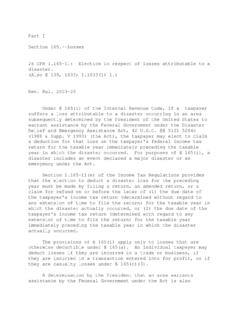Transcription of CHILDREN’S WITNESSING OF ADULT DOMESTIC …
1 Page 1 of 25 children S WITNESSING OF ADULT DOMESTIC violence Jeffrey L. Edleson University of Minnesota The author wishes to thank Susan Schechter and Andrea Bible for their helpful feedback provided on earlier versions of this manuscript. Running head: children s Experience of DOMESTIC violence Abstract Social service professionals are more frequently identifying children who witness ADULT DOMESTIC violence as victims of that abuse. This article expands common definitions of how children witness violence , and ADULT DOMESTIC violence in particular. Over 80 research papers were reviewed and a variety of behavioral, emotional, cognitive and physical functioning problems among children were found to be associated with exposure to DOMESTIC violence .
2 Factors that appear to mediate the impact of WITNESSING violence , such as child gender, age, and time since last exposure to violence are identified. Concerns about research methodology are also raised. children S WITNESSING OF ADULT DOMESTIC violence Many people have suggested that family violence at least to the degree it is observed today is a recent phenomenon. Yet violence between intimates has long been a part of family life. It has been described repeatedly in religious and historical documents across many centuries, dating as far back as the Roman Empire (Davidson, 1977; Dobash & Dobash, 1979). Some have also argued that current levels of family violence reflect a break-down in the moral structure of the family (see Levine, 1986).
3 This too is unlikely. Rather, as Gordon (1988) suggests, the ebb-and-flow pattern of concern about family that its incidence has not changed as much as its visibility (p. 2). children who witness violence between adults in their homes are only the most recent victims to become visible. These children have been called the silent, forgotten, and unintended victims of ADULT -to- ADULT DOMESTIC violence (Elbow, 1982; Groves et al., 1993; Rosenbaum & O Leary, 1981). Studies of archived case records from social service and governmental agencies provide ample evidence that violence has long occurred at levels similar to those measured today and that children are frequently present during violence incidents (Edleson, 1991; Gordon, 1988; Peterson, 1991; Pleck, 1987).
4 Page 2 of 25 An understanding of the current literature on how children witness violence and what developmental problems are associated with WITNESSING violence is an important foundation for program design and policy development. This article focuses on understanding how WITNESSING violence is defined and what we know about its effects on children . How Do children Experience DOMESTIC violence ? WITNESSING a violent event is most commonly defined as being within visual range of the violence and seeing it occur. For example, witnesses are often portrayed as giving an eyewitness account of a crime. Pynoos and Eth s (1984) studies of children who witnessed the murder of a parent reinforce this definition.
5 One example they offer is: Julie, a 4-year-old girl, was the only witness to her divorced mother s fatal stabbing. Several months earlier, at the time of the divorce, Julie s father had publicly threatened to kill his the father lacked an alibi for the night of the crime, there was no physical evidence linking him to the describing the event, she (Julie) consistently placed her father at the scene, described significant portions of the central action, and recounted her father s efforts to clean up prior to after the district attorney saw Julie stabbing a pillow, crying `Daddy pushed mommy down, did he become convinced that the father indeed was the murderer (p.)
6 100). A mother in a different study describes her daughter s involvement in a violent event this way: As (my husband) came back in the house and went in the bedroom and got another bullet and loaded the gun again and started to raise the gun, I really think my daughter saved my life right was holding her behind me, and she came out in front of me and put her arms in the doorway like this (demonstrating with her arms outstretched), so as he raised the gun it came right past her. And I reached out and I took her hands down, and her hands were so strong against that doorway. It was unbelievable the strength that was in her arms. I got her arms down, and I turned and grabbed her in my arms and ran out the door (Syers-McNairy, 1990, pp.
7 105-106). Pynoos and Eth (1984) suggest that at the core of the trauma for the child witness to homicide is a continued intrusion into the child s mind of the central Page 3 of 25 action when lethal physical harm was inflicted: the final blow with a fist, the plunge of a knife, or the blast of a shotgun (p. 91). Most children do not witness murders of a parent. Beatings that are not fatal but are nonetheless brutal are the types of events that we most commonly think of when children witness ADULT DOMESTIC violence . Peled (1993) provides dramatic testimony of one child WITNESSING such violence : I wouldn t say anything. I would just sit there. Watch was just, felt like I was just sitting there, listening to a TV show or s like you just sit there to watch it, like a tapestry, you sit there (p.
8 122). Being an eyewitness to a violent event is not, however, the only way that children describe their experiences. Many children describe very traumatic events that they have not visually observed, but rather that they have heard. One child described hearing fights this way: I really thought somebody got hurt. It sounded like it. And I almost started to cry. It felt really, I was thinking of calling, calling the cops or something because it was really getting, really big banging and stuff like that (Peled, 1993, p. 125). In their national curriculum for child protection workers, Ganley and Schechter (1996) highlight several additional ways that children experience ADULT DOMESTIC violence .
9 These include hitting or threatening a child while in its mother s arms, taking the child hostage in order to force the mother s return to the home, using a child as a physical weapon against the victim, forcing the child to watch assaults against the mother or to participate in the abuse, and using the child as a spy or interrogating him or her about the mother s activities. children are also frequently told by abusive fathers that their families would be together were it not for their mother s behavior, thus attempting to put pressure on the mother through the children to return to him or driving a wedge between the mother and her children . In addition to seeing, hearing or being used in a direct event of violence many mothers and their children describe the aftermath of a violent event as having a traumatic effect on them.
10 The aftermath can include a mother who is injured and in need of help, a father who alternates between physical violence and loving care, police intervention to remove a father from the home, or moving to a shelter for battered women. One mother, in her account to Syers-McNairy (1990), stated: It finally started to dawn on me that I was not the only person involved in it was when I left on the ambulance. They were so scared. And I Page 4 of 25 thought, they don t really have a now they re not going to have a mom? (p. 118). Any definition of WITNESSING violence must include all of these various ways in which children experience a violent event. They may see the violence or be used as a part of it, but more often they may hear the violent event and experience its aftermath.
